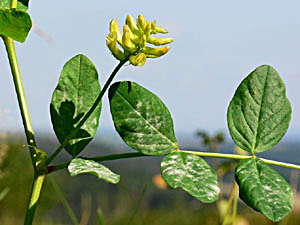
natural herbs
Milk Vetch
Astragalus glycyphyllos

Herb: Milk Vetch
Latin name: Astragalus glycyphyllos
Family: Leguminosae
Edible parts of Milk Vetch:
The herb is occasionally used as a tea. The root is said to be a liquorice substitute, but certainly not from the point of view of taste.Description of the plant:

Plant:
Perennial
Height:
20 cm(7 3/4 inch)

Flowering:
July toAugust

Scent:
ScentedPerennial
Habitat of the herb:
Rough grassy and bushy places.Propagation of Milk Vetch:
Seed - best sown as soon as it is ripe in a cold frame. A period of cold stratification may help stored seed to germinate. Stored seed, and perhaps also fresh seed, should be pre-soaked for 24 hours in hot water before sowing - but make sure that you do not cook the seed. Any seed that does not swell should be carefully pricked with a needle, taking care not to damage the embryo, and re-soaked for a further 24 hours. Germination can be slow and erratic but is usually within 4 - 9 weeks or more at 13°C if the seed is treated or sown fresh. As soon as it is large enough to handle, prick the seedlings out into individual pots and grow them on in the greenhouse for their first winter, planting them out into their permanent positions in late spring or early summer, after the last expected frosts.Cultivation of the herb:
Rough grassy and bushy places.Medicinal use of Milk Vetch:
None knownKnown hazards of Astragalus glycyphyllos:
Many members of this genus contain toxic glycosides. All species with edible seedpods can be distinguished by their fleshy round or oval seedpod that looks somewhat like a greengage. A number of species can also accumulate toxic levels of selenium when grown in soils that are relatively rich in that element.Plant information taken from the Plants For A Future.
